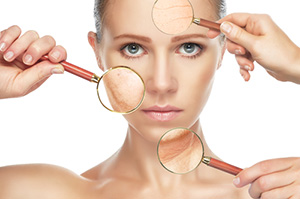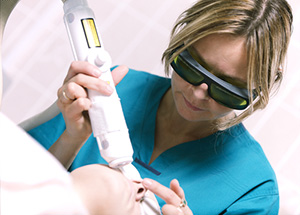Laser Resurfacing
 Erbium laser resurfacing is designed to remove surface-level and moderately deep lines and wrinkles on the face, hands, neck, or chest. One of the benefits of erbium laser resurfacing is minimal burning of surrounding tissue. This laser causes fewer side effects — such as swelling, bruising, and redness — so your recovery time should be faster than with CO2 laser resurfacing. In some cases, recovery may only take one week. Feel free to ask Dr. Garrett how long recovery is likely to take for you.
Erbium laser resurfacing is designed to remove surface-level and moderately deep lines and wrinkles on the face, hands, neck, or chest. One of the benefits of erbium laser resurfacing is minimal burning of surrounding tissue. This laser causes fewer side effects — such as swelling, bruising, and redness — so your recovery time should be faster than with CO2 laser resurfacing. In some cases, recovery may only take one week. Feel free to ask Dr. Garrett how long recovery is likely to take for you.
Erbium laser resurfacing may work better for you if you have a darker skin tone.
Preparing for Laser Resurfacing
Be sure to tell the doctor if you get cold sores or fever blisters around your mouth. Laser skin resurfacing can trigger breakouts in people who are at risk.
If you decide to go ahead with laser skin resurfacing, Dr. Garrett will ask you to avoid taking any medications or supplements that can affect clotting — such as aspirin, ibuprofen, or vitamin E — for 10 days before surgery. As well as sustain from any retina products for two weeks before surgery.
If you smoke, you should stop for two weeks before and after the procedure. Smoking can prolong the healing process.
Dr. Garrett may prescribe an antibiotic beforehand to prevent bacterial infections as well as an antiviral medication if you are prone to cold sores or fever blisters.
 What to Expect
What to Expect
Generally, laser resurfacing is an outpatient procedure, meaning there is no overnight stay. Procedures vary and the doctor may treat individual wrinkles around your eyes, mouth, or forehead or treat your entire face. For small areas, Dr. Garrett will numb the areas to be treated with a local anesthetic. If the doctor is just treating parts of your face, the procedure will take about 30 to 45 minutes. A full-face treatment takes up to two hours. Starting 24 hours after treatment, you will need to apply an ointment, such as petroleum jelly, to prevent scabs from forming. This wound care is intended to prevent any scab formation. In general, the areas heal in 10 to 21 days, depending on the condition that was treated. It’s normal to have swelling after laser skin resurfacing. Your doctor may prescribe steroids to manage swelling around your eyes. Once the skin heals, you can wear oil-free makeup to minimize redness. You will probably notice that your skin is lighter for a while after surgery. It is particularly important that you use a “broad-spectrum” sunscreen. When selecting a sunscreen, look for one with an (SPF) of 30 or higher. Also limit your time in the sun, especially between the hours of 10 a.m. and 2 p.m. Wearing a broad-brimmed hat can help protect your skin from the sun’s harmful rays.
Keeping your new skin well moisturized is also crucial to healing. If you use Retin A or glycolic acid products, you should be able to start using them again about six weeks after the procedure or when Dr. Garrett feels it is safe for your specific case.

